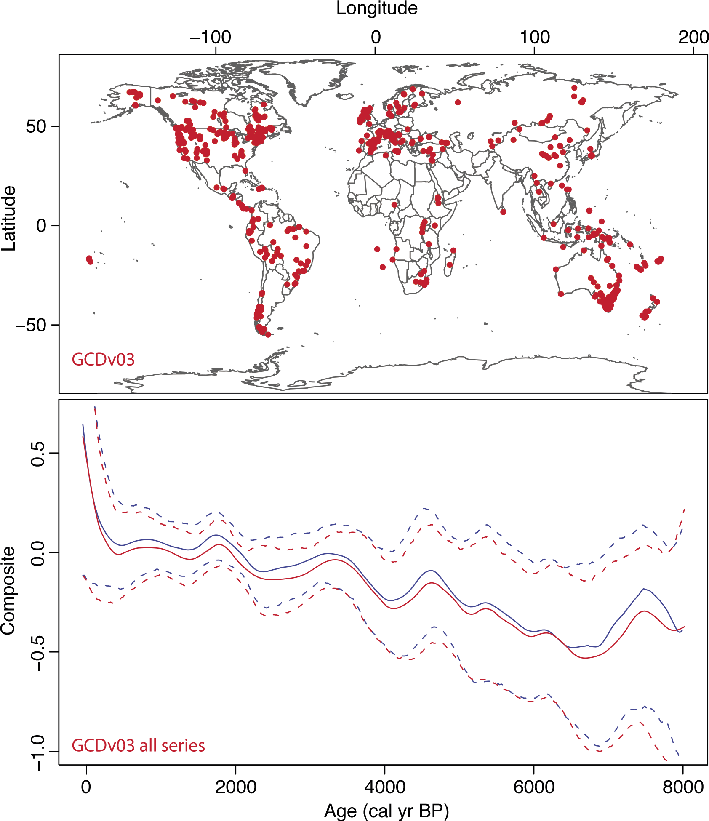- Home
- Publications
- PAGES Magazine
- Multi-Scale Analyses of Fire-Climate-Vegetation Interactions On Millennial Scales
Multi-Scale Analyses of Fire-Climate-Vegetation Interactions on Millennial Scales
Vannière B, Blarquez O, Marlon J, Daniau A-L & Power M
Past Global Changes Magazine
22(1)
40
2014
Boris Vannière1, O. Blarquez2,3, J. Marlon4, A.-L. Daniau5 and M. Power6,7
Workshop of the PAGES Global Paleofire Working Group – Frasne, France, 2-6 October 2013
The aim of the Global Paleofire Working Group (GPWG) is to facilitate scientific research on fire activity in the Earth system through the development of a global charcoal dataset (GCD). Analysis and synthesis of sedimentary charcoal records from around the globe has enabled the identification and explanation of spatiotemporal patterns in paleofire activity, created a framework for exploring fire-climate-vegetation linkages at decadal-to-millennial time scales, and allowed evaluation of fire model simulations at regional to global scales. Science emerging from the GPWG community includes a public-access database and multi-authored publications describing observed spatiotemporal changes in fire at global and regional scales as well as their causes and consequences (e.g. time series and maps; Power et al. 2008).
Paleofire science has developed rapidly during the past decade; new charcoal records are being produced, new statistical tools and analytical approaches are being developed, and novel strategies for combining multiple records for regional-to-global scale syntheses are being employed (e.g. Daniau et al. 2012). These recent developments present paleofire scientists with the challenge of dealing with highly quantitative, complex, and multivariate data documenting the timing, magnitude, and drivers of past fire activity (e.g. Vannière et al. 2011). Previous data exploration and synthesis of the GCD were done using analytical procedures developed by P.J. Bartlein (unpublished) using Fortran. The GPWG is currently developing toolkits using the R statistical language to broaden the access to students and researchers. The paleofire R package is allowing for rapid growth of GCD analyses and innovative paleofire studies.
The main objectives of this workshop were to 1) develop a new version of the GCD; 2) explore trends in fire history at the geographic scale of biomes using the new version of the dataset; 3) test and understand the operation of the newly developed paleofire R package, designed specifically to synthesize multiple records from the GCD (Fig. 1); and 4) discuss a new architecture for housing and disseminating the GCD into the future. The workshop was sponsored by the Region of Franche-Comté through the French-Swiss Environmental studies network, by UMR Chrono-Environnement (CNRS - University of Franche-Comté) and by PAGES. Fourteen participants from six countries (USA, Canada, France, Spain, Germany, China) and from various career stages presented their research, and were trained in the paleofire R-package functions. Moreover, version 3 of the GCD was prepared for public release. Participants were encouraged to develop new project ideas for global and regional charcoal syntheses. A set of comparative regional analyses that examine biome-scale fire signals and their forcings were initiated and are now in preparation for publication. Several other planned analyses, including regional studies and methodological research such as comparing micro- versus macro-charcoal records are also now underway. The paleofire R package can be installed directly from: http://cran.r-project.org/web/packages/paleofire/index.html
Finally, a new database architecture and web portal for the GCD was discussed and designed. The database is currently being transferred from ACCESS to MySQL in preparation for a large input of new data in the next version of the GCD and the new associated management needs. The new GDC will have a web-based user-interface to improve community access and use, as well as simplified data input and export. All of these enhancements are expected to greatly expand the user base of the GCD and thus promote paleofire research both within and beyond the paleo community.
affiliations
1Chrono-Environnement, CNRS, University of Franche-Comté, Besançon, France
2Centre d'Étude de la Forêt, Université du Québec à Montréal, Canada
3Forest Research Institute, Université du Québec en Abitibi-Témiscamingue, Rouyn-Noranda, Canada
4Yale School of Forestry & Environmental Studies, Yale University, New Haven, USA
5EPOC, CNRS, Université of Bordeaux, Talence, France
6Department of Geography, University of Utah, Salt Lake City, USA
7Natural History Museum of Utah, University of Utah, Salt Lake City, USA
contact
Boris Vannière: boris.vanniere univ-fcomte.fr
univ-fcomte.fr
references
Daniau AL et al. (2012) Global Biogeochem Cycles 26, doi: 10.1029/2011GB004249
Marlon JR et al. (2013) Quat Sci Rev 65: 5-25

